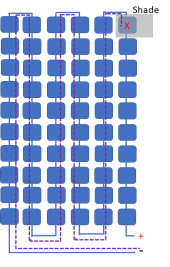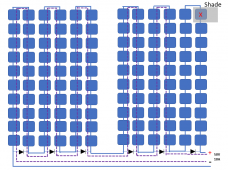FilterGuy
Solar Engineering Consultant - EG4 and Consumers
It is generally accepted that if you have shading on some of the solar panels, it is better to put them in parallel so the shaded panels don't impact the unshaded panels.
However, with modern panels that have two or 3 bypass diodes and MPPT controllers, is parallel really better? I am not sure it is.
Note: This turned into a long post, but stick with it to the end to see my non-conclusion to this question
Let's take a hypothetical panel that has no bypass diodes and creates 30V and 10A (300W) with no shade:

Now let's assume one of the cells gets shaded.

The shaded cell will block most of the current and have a high voltage drop across it so the panel output voltage and current will be very low. The resulting power output is negligible.
Now let's add in the bypass diodes

Now the current bypasses the portion of the panel that is blocking. For this example, that means the output current will be ~10A and the output voltage will drop by ~1/3 to ~20V for a production level of 200W. (Much better than negligible, but still a lot less than full power).
Now let's put two of these in series with one cell shaded.

The current will remain the same and the voltages will add. The result is 50V and 10A for 500W total production.
Finally, let's put two of the panels in parallel with one cell shaded. (This is where it gets interesting/confusing)

What will the output be? The unshaded panel is going to be producing 30V and the shaded panel is going to be producing 20V. If the panels were just driving a resistive load, the 30V would overwhelm the 20V panel and the total output would come from the unshaded panel; 300W (or less if the current is back feeding into the shaded panel). However, an MPPT controller will try to find the best operating voltage and current for maximum production of the total array. This means the voltage and current will be the best power point for the array, but sub-optimal for either panel. Since the I-V curves of panels are not linear, I don't think we can assume it will average to 250W per panel.... but I do not know what it will be. My gut tells me that the best case is that the MPPT does find a point where both produce 250W for a total of 500W. (The same as in serial panels). However, if they are creating the same power, it would still be better to go with serial because the lower current and higher voltage allow for smaller conductors and lower percent voltage drops.
Has anyone seen any data or studies on this?
However, with modern panels that have two or 3 bypass diodes and MPPT controllers, is parallel really better? I am not sure it is.
Note: This turned into a long post, but stick with it to the end to see my non-conclusion to this question
Let's take a hypothetical panel that has no bypass diodes and creates 30V and 10A (300W) with no shade:

Now let's assume one of the cells gets shaded.

The shaded cell will block most of the current and have a high voltage drop across it so the panel output voltage and current will be very low. The resulting power output is negligible.
Now let's add in the bypass diodes

Now the current bypasses the portion of the panel that is blocking. For this example, that means the output current will be ~10A and the output voltage will drop by ~1/3 to ~20V for a production level of 200W. (Much better than negligible, but still a lot less than full power).
Now let's put two of these in series with one cell shaded.

The current will remain the same and the voltages will add. The result is 50V and 10A for 500W total production.
Finally, let's put two of the panels in parallel with one cell shaded. (This is where it gets interesting/confusing)

What will the output be? The unshaded panel is going to be producing 30V and the shaded panel is going to be producing 20V. If the panels were just driving a resistive load, the 30V would overwhelm the 20V panel and the total output would come from the unshaded panel; 300W (or less if the current is back feeding into the shaded panel). However, an MPPT controller will try to find the best operating voltage and current for maximum production of the total array. This means the voltage and current will be the best power point for the array, but sub-optimal for either panel. Since the I-V curves of panels are not linear, I don't think we can assume it will average to 250W per panel.... but I do not know what it will be. My gut tells me that the best case is that the MPPT does find a point where both produce 250W for a total of 500W. (The same as in serial panels). However, if they are creating the same power, it would still be better to go with serial because the lower current and higher voltage allow for smaller conductors and lower percent voltage drops.
Has anyone seen any data or studies on this?
Last edited:


